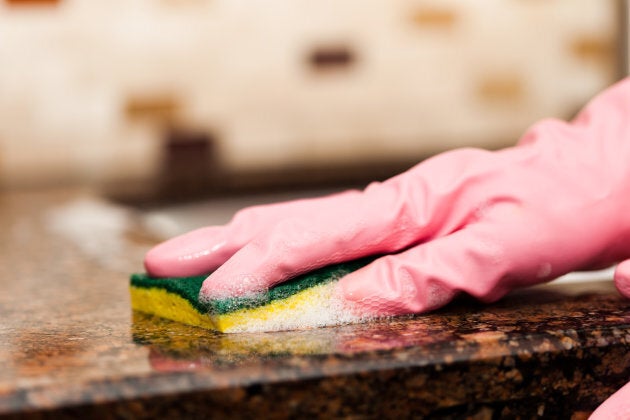What's the germiest place in the home? It's a question highlighted in numerous media stories several times a year. The answer usually ends up being a common item found in every household. It's the kitchen sponge.
You don't need to be a microbiologist to figure out why this is the case. Sponges have a high surface area, are capable of trapping small particles of food and other nutrients, and they tend to be wet. These are the perfect conditions for bacterial growth. Studies have shown every cubic centimetre contains millions of these microscopic organisms.
Knowing the levels of contamination definitely can increase the ick factor for any story. Yet, the information does not answer a second and more important question. Can any of the bacteria make us sick?
Research has looked into the potential of sponges to transfer pathogens and there is little doubt people may become exposed to due to cross-contamination. However, most experiments involve adding pathogens to the sponges or other surfaces and then observing the extent of spread. The goal is to mimic what happens in the home, which is useful in developing policies for safety.

Yet, the results cannot be extended to our everyday lives. That's why a team of German researchers took a different route in kitchen sponge science. They undertook an effort to find out whether sponges on their own pose risk of illness. Their results suggest the risk is there but minimal. Also, the troubles are easy to eliminate.
The team examined sponges collected from normal households over the course of one season. Back at the lab, the group broke down the sponges such that they could be used in individual experiments. The group examined certain sections visually by microscopy. Some of the portions were taken for genetic analysis to identify the species living within the matrix. Finally, several pieces were subjected to various cleaning methods to determine if any were superior in keeping sponges free of contamination.
When the results came back, there were numerous surprises. The first dealt with the actual level of contamination. Microscopic evaluation revealed the sponges were jam packed with bacteria. Numbers reached into the tens of billions per cubic centimetre, far higher than most other analyses. This meant previous research was only capturing a fraction of the actual bacterial population.
As to what types of bacteria were living in these populations, the team found a variety of species as expected. Not surprisingly, most were harmless environmental species. Of these, only one, known as Moraxella osloensishad any useful value as it causes bad odours such as those found in dirty laundry.
Several of the bacteria also demonstrate the ability to resist antibiotics, making them even more troublesome.
The most surprising result was the lack of any significant populations of foodborne pathogens such as Salmonella, Campylobacter, or Staphylococcus aureus. Their presence was minimal at best meaning the risk for gastrointestinal infection was quite low. But that didn't mean the threat was gone. That's because the team did find potential pathogens. They were just not gastrointestinal in nature. Instead, they caused respiratory and bloodborne infections.
The most prevalent species were from the genus Acinetobacter. Although you may not be familiar with the name, these bacteria are considered some of the most troublesome bacterial problems in healthcare. With names such as A. baumanii, A. haemolyticus, A. johnsonii and A. pittii, these microscopic invaders can cause pneumonia and have been found in many cases of the potentially lethal condition of bacterial blood infection known as sepsis. Several of the bacteria also demonstrate the ability to resist antibiotics, making them even more troublesome.
For the authors, finding these bacteria in the kitchen sponge suggests there indeed is risk for infection although for most people, it is quite low. Only those with a compromised immunity may have troubles if the levels of those Acinetobacter gets too high and end up in the lungs through droplet inhalation while washing or a "smell check."
How to stay safe
The results do not mean you should forgo the sponge anytime soon. As the authors point out, there are ways to stay safe. The best option is to replace the sponge once a week. The bacteria need that amount of time to get troublesome concentrations. Getting rid of them in the garbage eliminates any risk.
If this is a little too burdensome, two other routes to safety can also be used. You can put the sponge into the microwave on high for two minutes or you can immerse it in boiling water for at least sixty seconds. Both of these use the most effective means to kill bacteria, heat.
The only action not recommended is chemical disinfection. While this method is effective on surfaces and hands, when it comes to sponges the opposite effect appears to occur. As the authors found out, chemical treatment tends to allow resistant organisms to survive and thrive. This can lead to an even greater risk for troubles down the road.
Also On HuffPost: